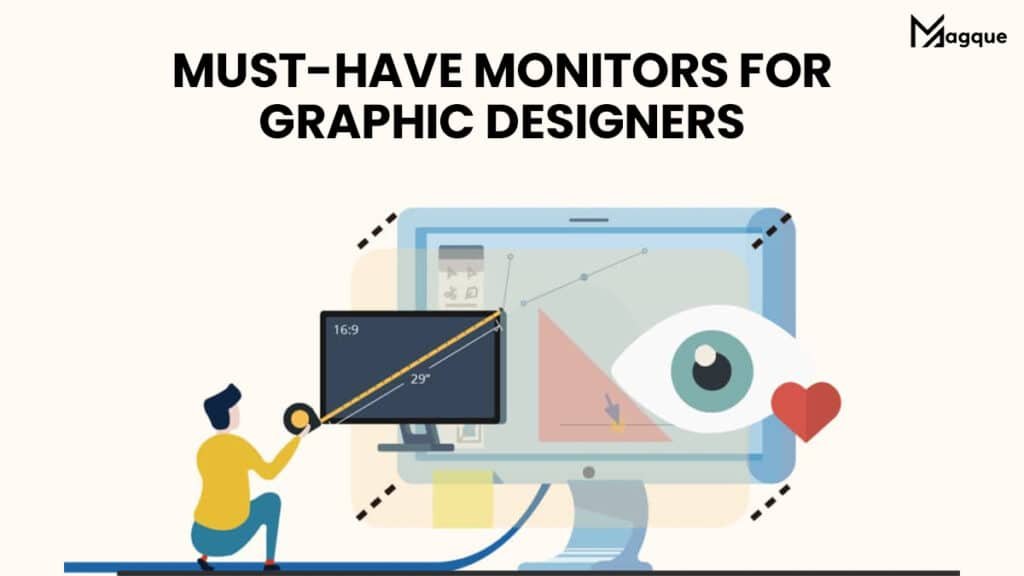When it comes to graphic design, the right tools can make or break your workflow. That’s why finding the perfect monitor is so crucial—it’s like finding the best partner in your creative journey. At Magque, we understand the importance of having a setup that meets and exceeds your expectations. So, what should you look for in a monitor if you’re knee-deep in graphic design?
Clarity and Color Accuracy
First off, let’s talk about clarity. For graphic designers, a crystal-clear resolution monitor is a game changer. Imagine working on a detailed illustration or editing a high-resolution photo. A monitor with a 4K resolution can be the difference between an okay design and a masterpiece. Why settle for less when precision is critical?
Color accuracy is another non-negotiable. The best monitors for designers boast an impressive color range, extensively covering sRGB and Adobe RGB spectrums. This ensures that what you see on screen is what you get in print—no surprises. Have you ever experienced the frustration of color discrepancies between your monitor and the final printed project? Yeah, it’s not fun.
Screen Size and Ergonomics
The size of the monitor also plays a pivotal role. A larger screen lets you see your projects fully without constantly zooming in and out. It’s like having a big canvas where you can splash all your creative ideas freely. An ergonomic design that allows for tilt, swivel, and height adjustment can save you from the dreaded neck and back pain. After all, who wants to end a productive day feeling like a twisted pretzel?
Connectivity and Features
Let’s not overlook connectivity. With the increasing use of tablets and other devices in graphic design, your monitor should have multiple ports. HDMI, USB-C, and DisplayPort should be on your checklist because you need that flexibility to connect all your devices seamlessly. Ever had to juggle between devices because your monitor couldn’t accommodate them all? Exactly, it’s a hassle no one should have to deal with.
Our Top Picks at Magque
At Magque, we’ve curated a list of monitors that meet all these criteria and more. From the ultra-precise Dell UltraSharp U2720Q to the budget-friendly BenQ PD3200U, each of these monitors has been tested by creative professionals who swear by their efficiency and durability. Why choose Magque? Because we believe in providing quality that supports your passion.
Why Trust Us?
Our recommendations are based on thorough research and real-life testing by graphic designers. We’re not just about sales but about empowering the creative community. Your trust keeps us going, and your success is our success.
So, whether you’re a seasoned designer or starting, having the right monitor is pivotal. And remember, at Magque, you’re not just buying a monitor but investing in your creative future.
Choosing the Right Monitor for You
It’s not just about picking any high-resolution monitor off the shelf. It’s about finding the one that meshes seamlessly with your creative process. Think of your monitor as a window to your imagination—the more transparent and more vibrant that window is, the more vivid your creations will be. Don’t you think it’s time to invest in a tool that transforms your visions into stunning realities?
In conclusion, upgrading to a professional-quality monitor is a decision you won’t regret if you’re serious about graphic design. Check out Magque’s selection today and see the difference a top-notch display can make in your design work. Ready to elevate your design game to new heights? We thought so. Welcome to the future of design—bright, bold, and brilliant.
Faqs
Q1.What features are most important in a monitor for graphic design?
For graphic design, the key features to look for in a monitor include high resolution (preferably 4K), excellent color accuracy, and comprehensive color gamut coverage (sRGB, Adobe RGB). Ergonomics also play a vital role, so adjustable stands that allow for tilting, swiveling, and height adjustments are essential for long work sessions.
Q2.How does screen size affect graphic design work?
Larger screen sizes provide more workspace, allowing designers to view multiple windows or applications simultaneously without constant switching or zooming. This can enhance workflow efficiency and reduce eye strain. Standard sizes for graphic design are 27 inches and above.
Q3.Why is color accuracy crucial for graphic designers?
Color accuracy is crucial because it ensures that the colors you see on the screen closely match the final output, whether digital or print. This is essential for maintaining the integrity of visual designs and ensuring client satisfaction with the final product.
Q4.Are curved monitors suitable for graphic design?
Curved monitors can be beneficial for graphic design as they provide a more immersive viewing experience and reduce distortion at the edges of the screen. They can also be easier on the eyes by giving a consistent viewing distance. However, preference varies among designers, and some may prefer flat monitors for precise line work.
Q5.What connectivity options should I look for in a graphic design monitor?
Look for monitors with multiple connectivity options, such as HDMI, DisplayPort, USB-C, and USB hubs. USB-C is particularly useful for designers using modern laptops and devices, as it allows for video, data, and power transmission through a single cable, keeping your workspace clutter-free.
Read Also This – The Best Graphic Design Software for Beginners
